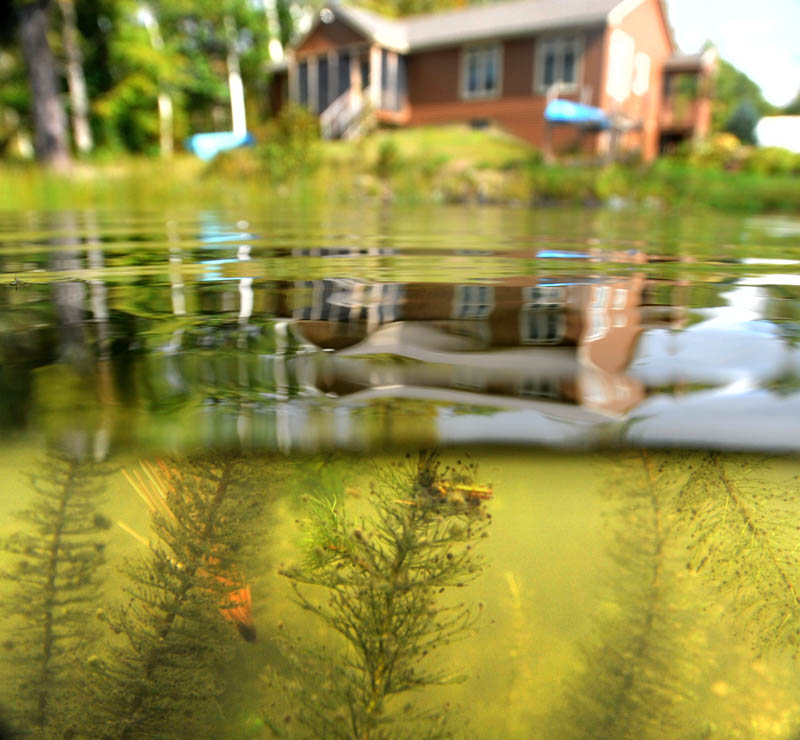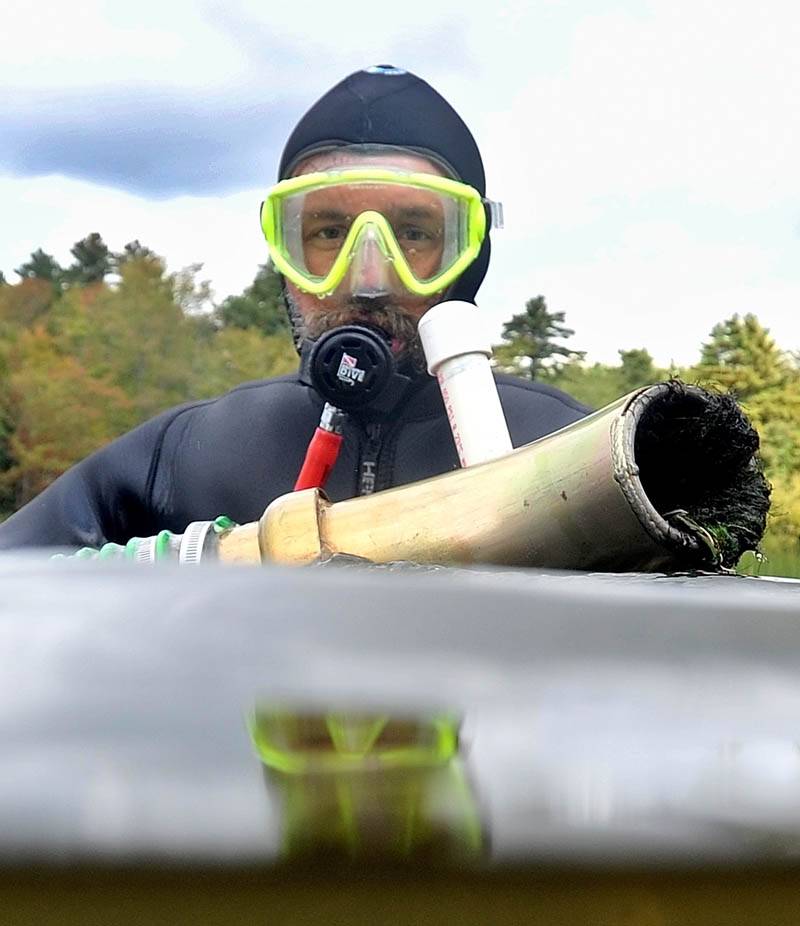OAKLAND — Brian Michaud is a hard hat diver who specializes in underwater construction and deep sea diving.
While he wore a wetsuit recently, he didn’t need a hard hat; his work environment was four feet of fresh water in a cove on Messalonskee Lake.
Michaud’s job was to suction a thick infestation of milfoil from the silty bottom.
As a loon slipped silently past a duck blind in a nearby marsh, Michaud climbed off the diver-assisted suction harvester — or DASH — boat and into the 69-degree water.
He adjusted his goggles, inserted an oxygen mouthpiece and wielded a large suction hose and garden trowel as he slipped under the surface near where Belgrade Stream enters the nine-mile-long lake.
Seconds later, milfoil, silt, and a mud puppy gushed from the 35-foot green, coiled hose attached to the suction device and into a storage container on the boat deck.
It was the second of four days of the fall milfoil removal project on Messalonskee Lake.
The lake is home to blue herons, bass, perch, sunfish, turtles, loons, bald eagles and Colby crew teams, but it also has six separate milfoil infestations.
This fall, the Friends of Messalonskee leased the DASH boat for four days from the Friends of the Cobbossee Watershed.
Ned Hammond, a member of the Friends of Messalonskee and homeowner on the lake, said that two infestation sites could possibly be tackled in that time.
The estimated cost is about $2,000, said Hammond.
That’s a small price to pay for friends of the lake, which is a popular spot for swimming, fishing, boating, sailing and water-skiing.
Milfoil’s long underwater stems branch out when they reach the water’s surface. The whorled leaves are featherlike and leaflets produce small red flowers.
Milfoil typically creates a thick canopy that crowds out other water plants and creates an imbalanced fish community. The dense mat of plants makes swimming difficult and can reduce property values.
“Nobody pays much attention until you can’t use your front yard, the water in front of your camp, anymore,” said Hammond. “If people can’t use the water in front of their place, they’ll go elsewhere.”
Hammond used his pontoon boot Wednesday to ferry coffee to Michaud and Brian Cole, who was piloting the DASH boat.
Hammond estimated milfoil has been in the lake about 15 years. Milfoil eradication is nothing new to the Friends of Messalonskee.
Last summer, as part of the eradification program, they placed benthic barriers on the sandy bottom in this same cove.
The barriers –perforated black polyester or plastic screens — block light so the milfoil underneath them is prevented from growing.
Milfoil, though, is persistent.
Experts say while it can’t be completely removed from a body of water where it has taken root, it can be controlled.
Three or four plants can establish a root system that’s two feet deep, said Cole.
To prove his point, Michaud stepped into a hole he had created after digging out a rootball; he nearly disappeared underwater.
Wednesday morning alone, Michaud had suctioned out and dug out 10 five-gallon buckets of the invasive plant.
Hammond said the buckets of removed milfoil are transported to the boat landing then disposed of at the transfer station.
While milfoil disperses itself via auto fragmentation — a piece of the plant breaks free, floats on the water and takes root in another part of the lake — people also unwittingly spread the invasive plant.
Hammond and Cole, who has fished in the lake for 25 years, urged boaters to clean their kayaks, canoes, sailboats, motorboats, propellers and trailers when leaving a body of water.
Beth Staples — 861-9252
bstaples@centralmaine.com
Send questions/comments to the editors.




Success. Please wait for the page to reload. If the page does not reload within 5 seconds, please refresh the page.
Enter your email and password to access comments.
Hi, to comment on stories you must . This profile is in addition to your subscription and website login.
Already have a commenting profile? .
Invalid username/password.
Please check your email to confirm and complete your registration.
Only subscribers are eligible to post comments. Please subscribe or login first for digital access. Here’s why.
Use the form below to reset your password. When you've submitted your account email, we will send an email with a reset code.